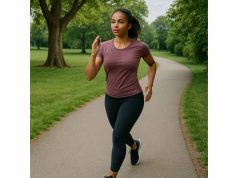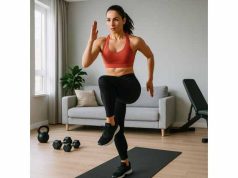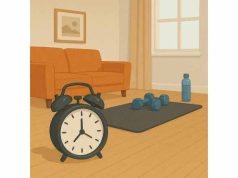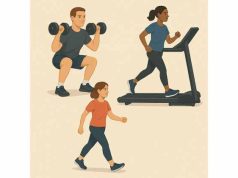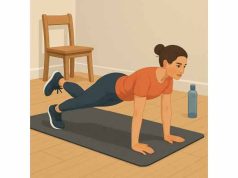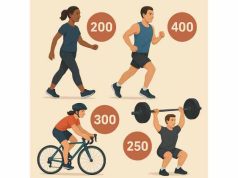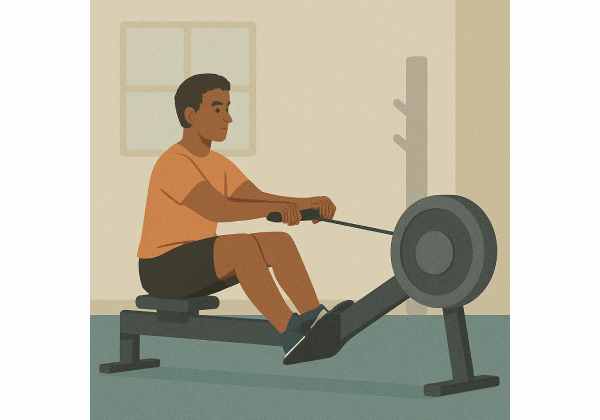
A rowing machine can become your most dependable weight-loss tool: low-impact, relentlessly scalable, and brutally honest about effort. Each stroke recruits legs, hips, back, and arms, so you spend more time moving big muscle groups and less time fighting joint stress. In this guide, you’ll learn how to row with efficient form, build interval sessions that actually burn calories, and progress across weeks without burning out. If you also strength-train and keep your daily steps consistent, rowing fits neatly into a sustainable plan. For a broader overview of how cardio, lifting, and walking work together, see our exercise strategies for weight loss guide.
Table of Contents
- Why rowing works for fat loss
- Technique: set-up and stroke
- Intervals that burn calories
- Steady state and Zone 2
- Progression: weeks 1–12 plan
- Strength and mobility support
- Common mistakes and fixes
- Frequently Asked Questions
Why rowing works for fat loss
Rowing for weight loss works because it checks every box that matters: large-muscle engagement, adjustable intensity, measurable output, and low orthopedic cost. Each stroke uses a coordinated drive from the legs, hips, back, and arms. That full-body demand raises calorie expenditure without the pounding you might feel while running.
You control intensity with simple levers. Pace (your split per 500 m), stroke rate (strokes per minute, or spm), and power (watts) respond immediately to your effort. That real-time feedback lets you target steady aerobic work for fat oxidation or short intervals for higher total energy burn. Because output is transparent, progress is easy to track.
Rowing also fits a wide range of bodies. Foot straps secure your feet, the seat glides to accommodate leg length, and the handle path is joint-friendly when technique is sound. For many people with cranky knees or ankles, rowing provides a high-return alternative to impact-heavy cardio.
Crucially, rowing helps you preserve muscle while you diet—less because it “builds” a lot of mass and more because it encourages you to use your lower body explosively under control. Paired with two or three short strength sessions each week, rowing supports the training stimulus you need to keep lean tissue while reducing fat.
Finally, rowing’s mind-body rhythm makes consistency more likely. You can stack 10 minutes after a lift, cruise a 30-minute Zone 2, or run a 20-minute interval block when time is tight. If you’re new to training or returning after a layoff, revisit safe fundamentals in our safe weight-loss essentials hub.
Key takeaways
- Full-body, low-impact movement raises calorie burn with less joint stress.
- Pace, spm, and watts make intensity objective and adjustable.
- Works alone or alongside strength training and daily steps for sustainable loss.
- Easy to scale from 10-minute warm-ups to longer base work.
Technique: set-up and stroke
Good form protects your back, preserves your knees, and makes every minute count. Think “legs first, then body, then arms”—and the opposite on the way back.
Set-up
- Foot stretcher height: Adjust so the strap crosses the widest part of your foot. You should reach the “catch” (front of the stroke) with shins roughly vertical.
- Damper vs. drag factor: The side lever controls airflow, not resistance in a fixed sense. For most people, a damper of 3–5 (moderate drag) promotes clean acceleration without yanking your back.
- Handle and posture: Sit tall on your sit bones, ribs down, eyes forward. Hold the handle with relaxed fingers—more hook than death grip.
The stroke (drive and recovery)
- Catch: Shins vertical, heels lightly down, torso leaning slightly forward from the hips (neutral spine), arms long.
- Drive—legs: Push the footplate away. Knees extend while arms stay straight and torso holds its angle.
- Drive—body: When the handle passes your knees, swing the torso from a slight forward lean to a slight backward lean (about 11 o’clock to 1 o’clock).
- Drive—arms: Finish by pulling the handle to the lower ribs with elbows traveling back, not flaring up.
- Recovery: Reverse the order—arms extend, body pivots forward, then legs slide to the catch. Move smoothly; the recovery is slightly longer than the drive to control breathing and heart rate.
Cadence and pacing
- Technique work and aerobic base: 18–22 spm.
- Moderate efforts: 22–26 spm.
- Short intervals and sprints: 26–32+ spm, but only if posture stays solid and the handle path remains clean.
Breathing
- Try “drive exhale, recovery inhale.” Let the recovery lengthen your breath to avoid breath-holding spikes in pressure.
Safety
- Keep the spine neutral; hinge at the hips. If your low back rounds at the catch, shorten the slide slightly and elevate the seat with a small pad.
- If mobility feels limiting, add 5–8 minutes of prep drills before rowing. See our guide on mobility and warm-up for simple flows.
Simple technique drills
- Pause at knees: On recovery, pause when the handle clears the knees to reset posture.
- Pick drill: Arms-only → arms + body → full stroke, 10–15 strokes each.
- Rate caps: Cap at 20 spm and hold consistent splits for 5–10 minutes.
When in doubt, slow the stroke rate, keep the chain level, and focus on long, hard drives rather than quick, choppy pulls.
Intervals that burn calories
Intervals compress a lot of work into a short window. They also make the machine less monotonous. Aim for sessions that are simple to pace and repeatable so you can progress.
How to set intensity
- By pace: Use your comfortable 2-km time (or a recent 10-minute test) as a benchmark. Hard intervals sit ~5–12 seconds faster per 500 m than steady work.
- By RPE: Hard intervals feel 8–9/10; recoveries feel 3–4/10.
- By heart rate: Work bouts near high Zone 4; recoveries in low Zone 2–3.
Beginner templates (choose 1–2 for 4–6 weeks)
- 30/60 x 10–12: 30 seconds hard, 60 seconds easy. Cap at 26 spm; aim to keep each work split within ±2 seconds.
- 8 × 250 m / 90 s easy: Hold even splits. Start conservative on the first two reps.
- Pyramid 1–2–3–2–1 minutes: Equal rest after each work segment. Pace the middle rep, then close hard.
Intermediate templates
- 6 × 500 m / 2:00 easy: Hold the first five within ±2 seconds; finish strong on the sixth.
- 3 × 6:00 / 3:00 easy: Sit at 24–26 spm, build every two minutes.
- Tabata (advanced-beginner+): 8 × 20 seconds hard / 10 seconds easy. Use sparingly; keep posture perfect.
Session structure
- Warm-up (8–10 minutes): Easy rowing with two 10-stroke pick-ups.
- Main set: 10–20 minutes of intervals as above.
- Cool-down (5–8 minutes): Easy rowing until breathing normalizes.
Weekly slotting
- Start with 2 interval days and 1–2 steady days (see next section).
- Keep total “hard minutes” modest at first (e.g., 10–15 minutes of true work).
- Progress by adding reps, shaving a second or two from splits, or raising spm while keeping technique clean—pick one lever at a time.
For context on when intervals outperform longer, easier work—and when they don’t—see our comparison of HIIT vs steady work.
Steady state and Zone 2
Rowing’s secret weapon for fat loss isn’t the lung-burning sprint—it’s steady work you can repeat often. This “talk-test” effort (you can speak in short sentences) builds mitochondria, improves technique under less fatigue, and keeps weekly volume high without crushing recovery.
Targets for Zone 2 rowing
- Duration: 20–45 minutes, depending on fitness and schedule.
- Stroke rate: 18–22 spm; prioritize long, powerful drives.
- Pace: Comfortable but purposeful; usually 15–25 seconds slower per 500 m than your moderate efforts.
- Heart rate: Roughly 60–70% of heart-rate reserve for many people (individuals vary).
Why it helps weight loss
- Increases the amount of work you can perform weekly without escalating fatigue.
- Encourages cleaner mechanics; technique improves when your lungs aren’t on fire.
- Supports appetite control better than constant all-out sessions for many trainees.
- Pairs well with strength days—10–20 minutes before or after the lift—so your total activity stays high.
Sample steady sessions
- Continuous 30: Hold 20 spm, negative-split the last 10 minutes.
- 3 × 10:00 / 2:00 easy: Same average output, brief breaks to reset form.
- “Steps” 12-15-18 minutes: Slightly faster each block with 2:00 easy between.
Want to learn more about pacing, zones, and how to test your aerobic threshold? See our primer on Zone 2 cardio.
Progression: weeks 1–12 plan
A clear progression prevents two common traps: doing the same workout forever or jumping too fast and stalling. Use the framework below, adjusting volume up or down by about 10–20% based on recovery and schedule. Keep one rule: finish sessions wanting one more rep most days.
Phase 1 — Foundation (Weeks 1–4)
- Frequency: 3–4 rows/week.
- Make-up: 2 steady sessions (20–30 minutes), 1 interval session, plus optional 10-minute technique row after strength.
- Goal: Own your set-up, learn consistent splits, cap at 22 spm on steady work.
- Progression lever: Add 2–5 minutes to steady sessions weekly or add one interval rep.
Phase 2 — Build (Weeks 5–8)
- Frequency: 4 rows/week.
- Make-up: 2 steady, 2 interval sessions.
- Goal: Extend one steady to 35–45 minutes; make intervals denser (e.g., 6 × 500 m instead of 5).
- Progression lever: Improve average split by 1–2 seconds on the same session or hold split while lowering spm by 1–2 (more power per stroke).
Phase 3 — Peak Consistency (Weeks 9–12)
- Frequency: 4–5 rows/week (optional fifth is short technique or recovery).
- Make-up: 2 interval days (one short, one longer threshold), 2 steady days.
- Goal: Consolidate gains without chasing hero efforts.
- Progression lever: Keep the same plan but reduce variability—narrow the spread between your best and worst rep to within 2 seconds.
Weekly templates
- 3-day week: M—Intervals (30/60 x 12). W—Steady 30. F—Steady 25 + 4 × 15-stroke pickups.
- 4-day week: M—Intervals 6 × 500 m. T—Steady 30. Th—Intervals 3 × 6:00. Sa—Steady 40.
- 5-day option: Add an easy 15–20-minute recovery row midweek.
Recovery and schedule hygiene
- Separate heavy lower-body lifting and hard intervals when possible.
- Sleep, hydration, and protein intake matter as much as the perfect plan.
- If soreness or life stress spikes, reduce interval frequency for a week.
For guidance on spacing hard efforts and rest, see our overview of rest-day planning.
Strength and mobility support
Rowing without strength work is leaving results on the table. Keep 2–3 short full-body sessions each week (20–40 minutes) to preserve muscle, support posture on the erg, and maintain the strength that protects joints as body weight drops.
Exercise menu (pick 1–2 per pattern)
- Lower body: Goblet squat, split squat, Romanian deadlift, hip hinge with kettlebell.
- Upper pull: One-arm dumbbell row, chest-supported row, band pull-apart.
- Upper push: Push-up variations, dumbbell bench or floor press, half-kneeling overhead press.
- Core/bracing: Dead bug, side plank, farmer’s carry.
Session templates
- Circuit A (2–3 rounds): Goblet squat 8–12, one-arm row 8–12/side, push-up 6–10, RDL 8–10, carry 30–40 m. Rest 60–90 seconds between moves.
- Circuit B (2–3 rounds): Split squat 8/side, floor press 8–12, band pull-apart 12–15, hip hinge 8–10, side plank 20–30 seconds.
Mobility and tissue care (5–10 minutes)
- Hip flexor and hamstring openers for a cleaner catch.
- Thoracic extension on a foam roller to keep the handle path level.
- Ankle dorsiflexion drills if shins cannot reach vertical without rounding the back.
Start each row with 5 minutes of easy strokes and a short pick drill; finish with gentle hip and back movement. For technique stability, targeted core work helps. See our guide to core training while dieting for simple progressions.
Common mistakes and fixes
Cranking the damper to 10. High drag punishes your low back and ruins rhythm. Use moderate drag (often damper 3–5) and focus on leg drive.
Short, choppy strokes. Low spm does not mean lazy; it means long, clean drives. Aim for 18–22 spm during base work with full compression at the catch and a strong finish.
Pulling with arms first. Sequence matters. Legs → body → arms on the drive; then arms → body → legs on recovery. Practice the pick drill weekly.
Only doing HIIT. Intervals help, but base work builds the engine that powers intervals. Most weeks: 1–2 interval days, 1–3 steady sessions.
Ignoring feedback. Track splits, spm, and session notes. Progress is steadier when you repeat comparable workouts and change one variable at a time.
Rounding the low back. Raise the seat slightly, shorten the slide, and hinge at the hips. If your hamstrings are tight, add mobility after the warm-up.
White-knuckle grip. Hook the fingers and relax the forearms; elbows travel back rather than flaring.
If pain persists (sharp, localized, or worsening), stop and consult a licensed clinician before continuing.
Frequently Asked Questions
Is rowing better than running for weight loss?
Both can work. Rowing is lower impact and recruits more upper-body muscle, which may help you accumulate volume with less joint stress. Running often burns slightly more per minute at higher speeds but can be harder to sustain. Choose the option you’ll repeat consistently.
How many minutes should I row to lose weight?
Start with 20–30 minutes per session, three to four days per week. Mix one interval workout with two or more steady rows. As fitness improves, extend one steady session to 40–45 minutes or add interval reps. Total weekly minutes matter more than any single workout.
What damper setting is best for fat loss?
There’s no magical setting for fat loss; energy burn comes from effort and time. For most people, a moderate damper 3–5 balances control and power. Prioritize smooth strokes, consistent splits, and sessions you can repeat. Increase work gradually rather than chasing heavy drag.
How often should I row each week?
Most lifters and busy professionals do well with three to five rowing sessions weekly: one to two interval days and two to three steady rows. If you also strength-train, keep the hardest intervals away from heavy leg days and include at least one lighter recovery row.
Does rowing build muscle or only cardio?
Rowing primarily trains the aerobic system and muscular endurance. It can maintain leg and back strength, but it’s not optimal for muscle gain. Combine rowing with two to three short strength sessions weekly to preserve muscle while losing fat, especially for the legs, back, and core.
What’s a good beginner split time per 500 m?
“Good” is relative to size, experience, and technique. Instead of chasing a universal number, aim to hold even splits across a session and reduce them gradually (1–2 seconds) over weeks. As you improve, you can compare like-for-like workouts to see steady progress.
References
- WHO guidelines on physical activity and sedentary behaviour — 2020 (Guideline)
- High-intensity interval training is not superior to continuous aerobic training in reducing body fat: A systematic review and meta-analysis of randomized clinical trials — 2023 (Systematic review & meta-analysis)
- Energy expenditure, oxygen consumption, and heart rate while exercising on seven different indoor cardio machines at maximum and self-selected submaximal intensity — 2024 (Comparative study)
- Trunk Muscle Activities during Ergometer Rowing in Rowers with and without Low Back Pain — 2023 (Observational study)
- Weight Loss and Exercise Differentially Affect Insulin Sensitivity, Body Composition, Cardiorespiratory Fitness, and Muscle Strength in Older Adults With Obesity: A Randomized Controlled Trial — 2021 (RCT)
Disclaimer
The information in this article is for educational purposes only and is not a substitute for personalized medical advice. Consult your physician or a qualified health professional before starting any new exercise or nutrition program, especially if you have cardiovascular, orthopedic, or metabolic conditions.
If this guide helped you, consider sharing it with a friend. You’re welcome to follow us on Facebook or X for new training templates and evidence-based updates.

